Khurram Qumar Siddique
Principal Business Process Consultant for Utility, Avertra Corp, Herndon (VA), USA
Correspondence to: Khurram Qumar Siddique, Principal Business Process Consultant for Utility, Avertra Corp, Herndon (VA), USA.
| Email: |  |
Copyright © 2024 The Author(s). Published by Scientific & Academic Publishing.
This work is licensed under the Creative Commons Attribution International License (CC BY).
http://creativecommons.org/licenses/by/4.0/

Abstract
This research paper introduces a novel method and system for seamlessly integrating third-party service charges into monthly utility bills, addressing a common challenge in the deregulated utility market. The system establishes a communication bridge between the service provider and the customer's utility provider, facilitating the request to add a third-party service to the customer's account. The core of the invention lies in three parts: the first part maintains the communication bridge to process service requests; the second part involves master data processing, which includes configuring the utility bill format to accommodate third-party service charges; and the third part circulates information regarding the outcome of the integration process. The system is designed to generate a file based on the result of the file processing, indicating either successful enrolment and bill generation for the third-party service or providing reasons for unsuccessful addition. This innovative approach not only simplifies the billing process for utility companies but also enhances customer satisfaction by offering a consolidated bill that includes both utility and third-party service charges.
Keywords:
SAP S/4 HANA, SAP cloud connection, Service line Protection plan, SAP Billing Engine, SAP S/4 HANA (on-premises), SFTP server, SAP Rate Structure, ERP database
Cite this paper: Khurram Qumar Siddique, Seamless Integration of Third-Party Service Charges into Utility Bills: Leveraging SAP S/4HANA and SAP Cloud Connector, Computer Science and Engineering, Vol. 14 No. 1, 2024, pp. 7-14. doi: 10.5923/j.computer.20241401.02.
1. Introduction
1.1. Background
The service line protection plan charge typically refers to a type of insurance or coverage that helps protect homeowners from the high costs associated with repairing or replacing damaged utility service lines running into their homes or properties. This coverage may include protection for various service lines such as Gas, water, sewer, and electrical lines. The charge for this plan is often billed to consumers through their monthly utility bill and is designed to provide financial assistance in the event of damage to these essential service lines. It is important for consumers to understand the coverage, costs, and terms associated with these plans before enrolling. The Deregulation of energy markets has created new business dynamics [4]. These deregulation process significantly impacted the customer-oriented business processes of utility companies. In the utilities industry, these processes often span multiple systems within an organization and across companies with various market participants. The providers of utility supply (Gas/Electricity/Water) are referred to as service providers but specifically the provider of protection plans for service lines are known as warranty providers. But hypothetically they are the service provider for the distributor Company. These providers were created in distributor company. In our case the distributor company is using SAP S/4 HANA (on-Premises).
1.2. Problem Statement
Utilities often face difficulties in integrating billing modules for third-party services due to the complexity of their existing ERP systems and the lack of standard solutions for such integrations. The technical challenge of integrating third Party services with existing systems and processes can be significant, especially if they are not compatible to exchange the information. After the resolution of the exchange of the data from third party, the next challenge for the utility company would be to store and update the data and generate the utility bill as per the regulatory rules and regulation. The utility provider should print the details about the third-party charges in separate lines. To address the challenge, this document proposes the custom solution by using Advance Business Application Programming language supported on SAP. This document outlines the key element of solution for generating the service charge along with SAP utility monthly bill cycle, it includes the file communication with the service provides, master data changes in the SAP database. The aim of the document is to provide a step-by-step process guide to pick the third-party files, respond to the third party and merge third party service charges in SAP billing schema. The goal is to help business overcome the challenges of sending a single utility monthly bill that includes all the consumption charges of utility and third-party products too.
2. Methodology
2.1. Evaluation
SAP supports custom solutions it uses Advance Business Application Programming language (ABAP). Utility companies in the deregulated market must share the information, it includes the enrolment file, billing file, response file, and payment file. Intercompany Data Exchange (IDEx) is a specific module of SAP S/4 HANA to maintain communication with service providers. This Evaluation uses the Advance Business Application programming language to create new functional modules to pull the data from files and place the data in custom tables. Furthermore, it uses the data and merges with the utility Billing schema. It includes generating sperate lines for bill print. This evaluation provides the solution to pick up the file from the FTP server through the Cloud connection on SAP S/4 HANA (on premise) [1]. Solution uses the enrolment data from the files and places it on the custom tables. It makes the decision for acceptance or rejection for further processing. It creates a custom user-friendly screen to check the relationship of the customer and service product.This evaluation provides the solution to create billing rates with custom variant function module that has the functionality to pick the data from custom tables and use the data for billing calculation. This evaluation uses the automation upon the move-out request for customers. It drops the protection plans automatically on the departure of the customer from the utility company. It updates the custom tables with drop date, and it stops billing for the customer. This Evaluation is set up to automatically generate a response file to the third-party service whenever there is an update with the consumer.
2.2. Other Approaches
SAP Provide the IDOC modules solution to communicate with the third-party service provider. It involves the workflow functionality to enroll the customer in the standard SAP screen. But Business don’t want to merge the Service line protection plan with standard SAP screen. As it might be very complex for business users. Business Wants to use the custom screen for service line protection plan. It became a challenge to merge the workflow functionality with custom screens/tables. This evaluation comes up with picks up the file from SAP directories and pass the data in the custom tables and generate the service charge along with utility bill.
2.3. Design Overview
To understand the design through this document we need to divide the evaluation into three parts. Let’s take the overview about it and technical details would provide in the later part of this document 1. Integration of SAP with Non- SAP system for File communication.2. Data processing into the SAP database.3. Bill Generation.
3. Technical Detail
3.1. Technical Detail about File Communication
With deregulation, utilities companies have unbundled their previously integrated services, which has led to mergers and brought new companies into the business. With the unbundled services, new companies in the marketplace, and new kinds of services being offered to customers, the industry has become much more dynamic, with new business processes emerging. Many of those new processes rely on electronic exchanges of data between companies to conduct basic business functions, as well as keep the supplies of energy flowing reliably and securely. However, recent events have also shown an urgent need for transparency, traceability, and auditability in industry transactions. SAP S/4 HANA (on- premises) provide the functionality to connect FTP (File Transfer Protocol) server and SFTP (Secure File Transfer Protocol) through the Cloud connector [1,2,3]. Innovation uses SAP cloud connection for file communication with service provider. Below files are required for the innovation • Energy Choice List• Customer Enrolment file • Drop File • Enrolment response file • Monthly Confirmation file • Daily Billing File• Daily Payment file • Daily Activity File Enovation uses the background job execution functionality of SAP. It executes overnight and pick the Customer enrolment and drop file. It provides those files to the second part of the innovation to generate/update the master data. It is used to generate the file from SAP for service provider. It generates the files too for the service providers.
3.1.1. Customer Enrolment File
Customer Enrolment file provided by the service provider. It has information about the customers that are interested in the Service Line Protection services. The file contains the information for Service Provider, customer account, Product type and enrolment start date. Logic picks up the file from directory and updates the custom table with the basic information of service provider, customer account, product type, product code and enrolment start date.
3.1.2. Enrolment Response File
The enrolment response file generated by SAP system. This file contains information about all the rejected contract accounts. This file is a critical component of the enrolment process, particularly in the context of various systems and programs. It contains specific information and rejection codes that are essential for customer enrolment. The content of the response file, including error codes, disposition information, and other relevant details, plays a vital role in ensuring the accuracy and completeness of the enrolment process. The information contained in the response file enables stakeholders to address errors, make necessary corrections, and facilitate the successful processing of enrolments. The proper handling and interpretation of the content within the enrolment response file are integral to maintaining data integrity and effectively managing the enrolment process.
3.1.3. Daily Billing File
The daily billing file generated by the SAP system plays a crucial role in facilitating accurate and efficient billing processes for utility companies or service providers. It provides detailed information about customer accounts, consumption patterns, and charges, helping organizations manage their billing operations effectively.
3.1.4. Drop File
Drop file provided by the service provider. It has information about the customers that are no longer interested in the Service Line Protection services. The file contains the information for Service Provider, customer account, Product type and drop date. Logic picks up the file from directory and updates the custom table with drop date and stops the billing.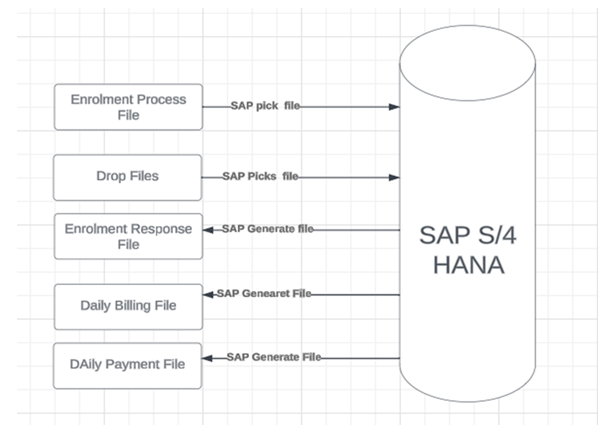 | Figure 1. Input/output File communication |
3.2. Technical Detail about Data Processing
Innovation involves the creation of a master data table to accommodate the unique billing needs associated with the third-party protection plans. Innovation Uses SAP ABAP (Advanced Business Application Programming) to create Z-tables to support the generation of monthly bills for the protection plan within the SAP environment. We created Z-tables for service providers, products type and price and store the data from customer enrolment file. At the end we created a Z-table for successfully enrolled customers in the protection plan (Z tables are accessed in a similar manner to standard tables and are used when customization is necessary to meet client-specific requirements). [11]
3.2.1. Service Provider Information
The process involves adding the Service provider as a business partner in the SAP system, including relevant details such as address, identification, and jurisdiction code. Subsequently, a contract account is created for the business partner, with the assignment of account class, authorization group, and payment type. Additionally, a service provider is established with an external number, and a service agreement is created. However, since the SAP standard solution does not inherently support the association of the third-party service provider with the product code, a custom master data table can be developed to capture this specific combination. Custom logic picks the service provider, service code and line item from provided customer enrolment file. **Later in the document will use as Z-Table 1Table 1. Service Provider Information
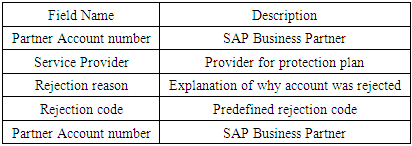 |
| |
|
3.2.2. Product and Price
This Z-table would enable the maintenance of the product list, pricing details, and any updates or changes made by the third-party service provider.** Later in the document will use as Z-Table 2Table 2. Products and Prices Information
 |
| |
|
3.2.3. Enrolment File
This Z-table would be used to store all the information from the Customer Enrolment File. Batch job picks the Customer Enrolment file and populates this table with the data. It is important to note that, as of now, the decision of whether a customer is enrolled or not enrolled has not been made based on this information. ** Later in the document will use as Z-Table 3.Table 3. Enrolment File Information
 |
| |
|
3.2.4. Successfully Enrolled Customers
The custom master data table is not a direct entry table, and it populates through the program's logic. At this stage, the program has finalized the decision of whether a customer is finally enrolling with the provider or if they are rejected due to misleading information. Custom program logic verifies enrolment file information with the custom tables as well as standard tables of SAP. If logic finds no misleading information, then it inserts the record in table but if it finds any then it inserts the record in enrolment response file. ** Later in the document will use as Z-Table 4.Table 4. Logic for Data Processing
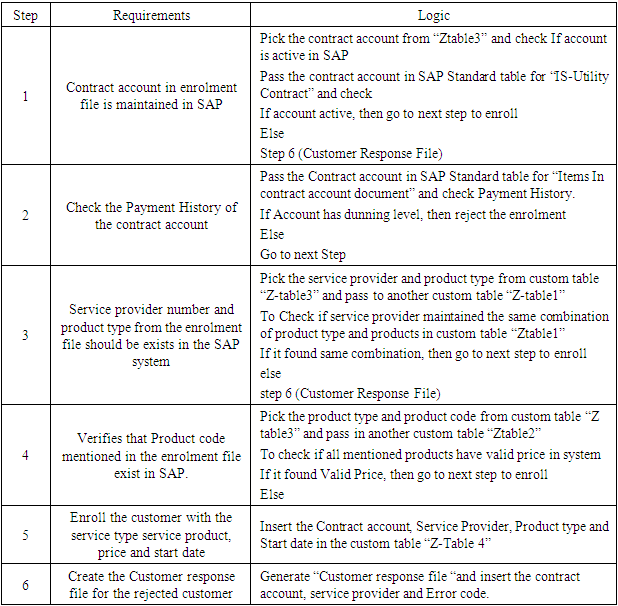 |
| |
|
Above mentioned logic inserts the contract account with product type, Product code and price in the Successful Enrolled customer table but it won’t provide the value of the Actual enrolment Date. Below Logic uses to provide the value of the Actual Enrolment date. Customers have 10 calendar days to cancel the contract with the service provider. If we receive the cancelation file in the recession period of 10 days, then update the cancelation reason in Warranty Service program table. But if we won’t receive any cancelation file for the customer, then use the below logic to update the enrolment date. | Figure 2. Customer Enrolment date calculation logic |
 | Figure 3. Customer Enrolment date calculation logic |
Table 5. Logic for Enrolment date calculation
 |
| |
|
3.2.5. Enrolment Response date and time
Logic tries to process the data from table “Z-Table3” but if information is not matched with Z-table 1 and Z-table 2 (master data table) then logic generates the enrolment response file with the rejection code. Table 6. Enrolment Response File
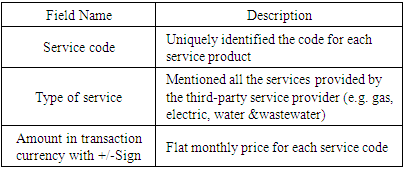 |
| |
|
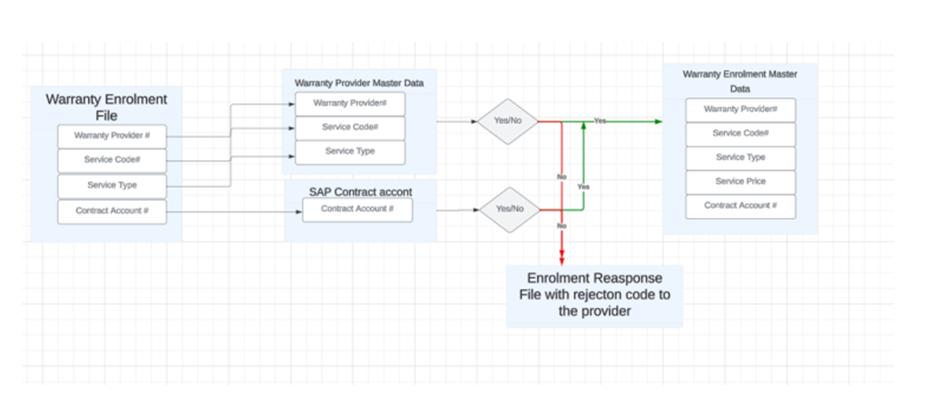 | Figure 4. Protection Plan Enrolment Process Overview |
**Logic uses the code to process enrolment response file. Service provider picks up the response file and updates the information as per the rejection code. Provider can resend the file for re-process of the enrollment**
3.3. Technical Detail about Bill Generation
To generate bills along with SAP, we have developed a custom logic that picks the product and price data from the custom table where protection plan data is stored. This ensures that the bill generation process is seamlessly integrated with SAP, even though the data is stored in a custom table. Our solution considers the various components of the SAP standard rate structure such as Rate, Rate Type, Variant Program, Operands, Line-Item Type, Rate category, and Billing Schema to ensure accurate and comprehensive billing. With this custom solution, we have been able to streamline the billing process and provide our clients with a reliable and efficient billing system.
3.3.1. Custom Variant Program
Billing Variant Program is a set of selections or input values that are used when running a program to generate bills. SAP standard Variant can’t pull the data from custom table. But SAP provides the functionality to create Custom variants for custom requirements. They provide flexibility and customization options for users to adapt standard forms to their unique needs. Innovation involves creating the custom variant, it checks the custom table to determine the third-party service provider and product price. The custom variant program is designed to accept a protection plan service code as an input and determine if a customer is enrolled in that specific service. The program has one input operand of type USERDEF, which will receive the service code from the custom table “Successful enrolled customer “. The program will then perform a check based on the received service type code and return a value of either '1' or '0' to the FACTOR output operand. The value '1' will indicate that the customer is enrolled in the specified service, while '0' will signify that the customer is not enrolled in the specified service.
3.3.2. Billing Rate
SAP allows us to create a tailored rate based on the user specific requirement. We need to use the custom variant in the billing engine. It will connect through the rate. We will create a new rate and assign the custom variant to it. Table 7. Logic for Rate Steps
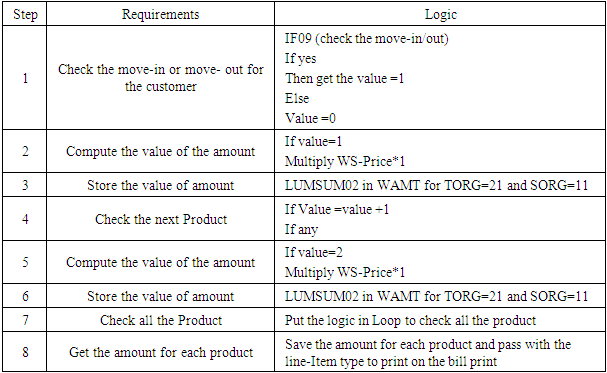 |
| |
|
3.3.3. Line-Item Type
It is evident that the process of showing the service line protection plan charge as a specific line item in the bill involves creating a new line-item type for the rate. This new line-item type is used to represent the service charge and can have a specific description for each product. The customization of item types and descriptions allows for a more meaningful representation of third-party service charges in the billing documents. These line Item used to be same as service code to avoid confusion. e.g. WPE001 for Gas Line Protection, WPE004 for Water Line protection plan etc.
3.3.4. Rate Fact
Rate facts are relevant to the rate fact group and are used to enter operand rates. The rate fact group serves as a mechanism for organizing and managing these rate facts, allowing for the association of specific values with the operands used in rate calculations. By linking rate facts to the rate fact group, users can ensure that the appropriate values are available for the operands used in various billing and pricing scenarios. We create a rate fact as per the service line protection plan.
3.3.5. Rate Type
Rate types can be allocated to register, device rate category, or installation, and they play a crucial role in classifying registers for billing. Rate type is a key factor in rate determination, where the system considers all rates associated with the installation [5].We created a couple of new rate types for billing. We use rate type for installation. We planned to pull the rate from installation. So, we created a rate type for installation facts.
3.3.6. Rate Determination
Rate determination in the context of SAP refers to the process of identifying and applying the most appropriate rate for pricing or billing purposes based on specific criteria and attributes. We used the rate determination to assign the newly created service line protection rate and rate type with the existing rate category.
3.3.7. Billing Schema
The billing schema serves as a mechanism for grouping together various rates and defining the criteria assigned to those rates for billing purposes [5]. It allows the organization and management of rates. During rate determination, the required rates are picked based on the configured rules and conditions. We haven’t created any new billing scheme. We just add the rates to the existing billing scheme.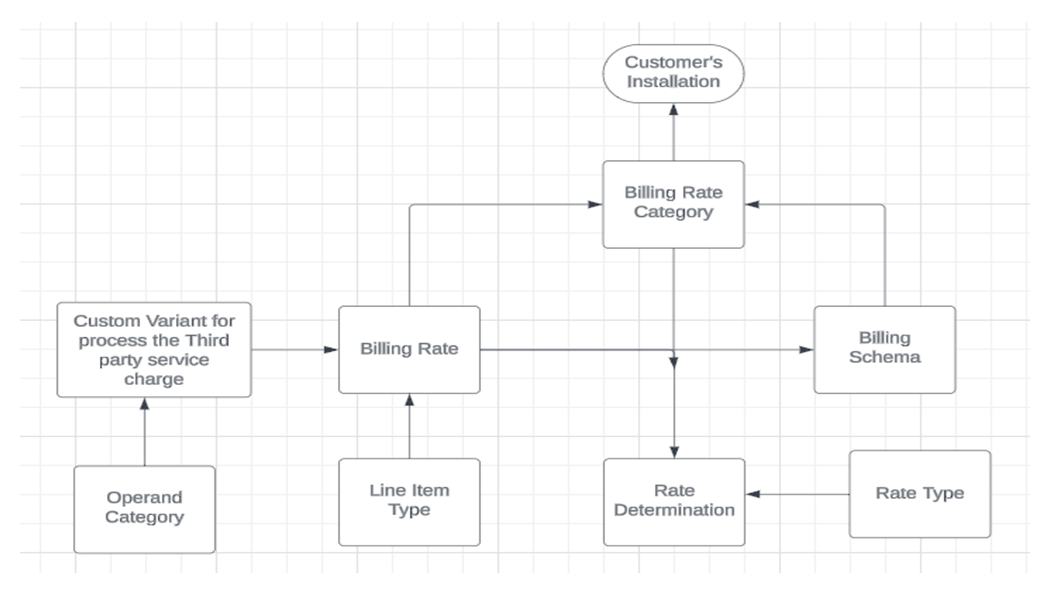 | Figure 5. Rate Structure Overview |
4. Benefits of Integrating Third Party Services in the Utility Bill
1) Convenience for Customers: By integrating third-party services with utility bills, customers can manage and pay for multiple services through a single platform, making the process more convenient and efficient. [6]2) Reduced Billing and Payment Processing Costs: Integrating third-party services can lead to reduced billing and payment processing costs, as it allows for the consolidation of multiple services into a single bill. [7]3) Enhanced Customer Service: The integration of third-party services can enhance customer service by providing a more comprehensive service offering and a single point of contact for customer inquiries. [8]4) Increased Revenue Opportunities: By offering additional services, utility companies can create new revenue streams and increase customer retention. [7]5) Improved Regulatory Compliance: Integrating third-party services with utility bills can help utility companies comply with regulatory requirements, as the burden and costs of compliance are often shared or managed by the third-party service provider. [6]6) Marketing Opportunities: The integration of third-party services provides an opportunity to include dynamic marketing messages in utility bills, promoting additional services and offers to customers. [7]7) Greater Control over Accounting and Billing Processes: Integrating third-party services with an ERP system can provide end-to-end control over operations, helping to address gaps in accounting and billing processes. [8]8) Enhanced Security: Some third-party integrations can offer improved security measures, ensuring the protection of sensitive customer data. [10]
5. Use Case (Possible Future Extension)
The methodology outlined in the article can be applied to various use cases beyond the integration of the protection service line charges, such as 1) Water Treatment Services: Services related to the treatment and purification of water, ensuring a safe and clean water supply. A third party can sale the service Plans/Packages to consumers. Utility Companies can add these program’s charges in the Utility bill [9]. 2) Home Warranty Services: Coverage for the repair or replacement of major home systems and appliances due to wear and tear. A third party can sale the service Plans/Packages to consumers. Utility Companies can add these program’s charges in the Utility bill [9]. 3) Energy Efficiency Programs: Programs that provide services or products aimed at reducing energy consumption, such as energy audits, insulation upgrades, or energy-efficient appliances. A third party can sale the service Plans/Packages to consumers. Utility Companies can add these program’s charges in the Utility bill. [9] 4) Trash Disposal Service: -Trash Disposal Service can provide the disposal plan/packages to the consumer. A third party can sale the service Plans/Packages to consumers. Utility Companies can add these program’s charges in the Utility bill [9]. 5) Security Services: Install the Home security equipment and cameras for securing home/ offices. A third party can sale the service Plans/Packages to consumers. Utility Companies can add these program’s charges in the Utility bill.
6. Conclusions
The conclusion of the abstract would highlight the following key point.• The challenges associated with integrating third-party charges with the monthly utility bills using SAP S/4HANA for Utilities, including the complexities of receiving enrolment files from a non-SAP system and adding corresponding products/packages to the consumer's profile.• The necessity of developing new functionalities to support adding these line Items to the monthly utility bill, as these charges have a fixed monthly price and are not part of the standard SAP Master data.• The Proposed solution, which include file communication for picking up the files, providing the response file and generating the monthly bill to address the challenges outlined.• The significance of the proposed solution in overcoming the integration challenges and ensuring a seamless process for incorporating the third-party service line protection plan charges in the SAP Standard Billing.
References
| [1] | https://community.sap.com/t5/technology-blogs-by-sap/cloud-integration-how-to-setup-secure-connection-to-sftp-server/ba-p/13326588 |
| [2] | https://community.sap.com/t5/technology-blogs-by-sap/cloud-integration-how-to-connect-to-an-on-premise-sftp-server-via-cloud/ba-p/13379016 |
| [3] | https://community.sap.com/t5/technology-blogs-by-members/configuration-of-ftp-and-sftp-adapter-in-cloud-integration-cpi/ba-p/13508004 |
| [4] | Utility Deregulation Requires Effective E-Business Standards.pdf |
| [5] | https://pubs.sciepub.com/jcsa/12/1/1/ |
| [6] | https://www.reloadly.com/blog/bill-payment-aggregators/ |
| [7] | https://electricenergyonline.com/energy/magazine/49/artcle/outsourcing-your-billing-system-considerations-benefits-and-profits.htm |
| [8] | https://wezom.com/blog/7-energy-and-utilities-industry-challenges-and-how-we-solve-them |
| [9] | https://tridenstechnology.com/utility-billing-software-solutions/ |
| [10] | https://thecitybase.com/blog/why-utilities-shouldnt-outsource-walk-in-payments-to-pay-agents |
| [11] | https://community.sap.com/t5/enterprise-resource-planning-q-a/what-is-z-table/qaq-p/3304584 |








 Abstract
Abstract Reference
Reference Full-Text PDF
Full-Text PDF Full-text HTML
Full-text HTML





